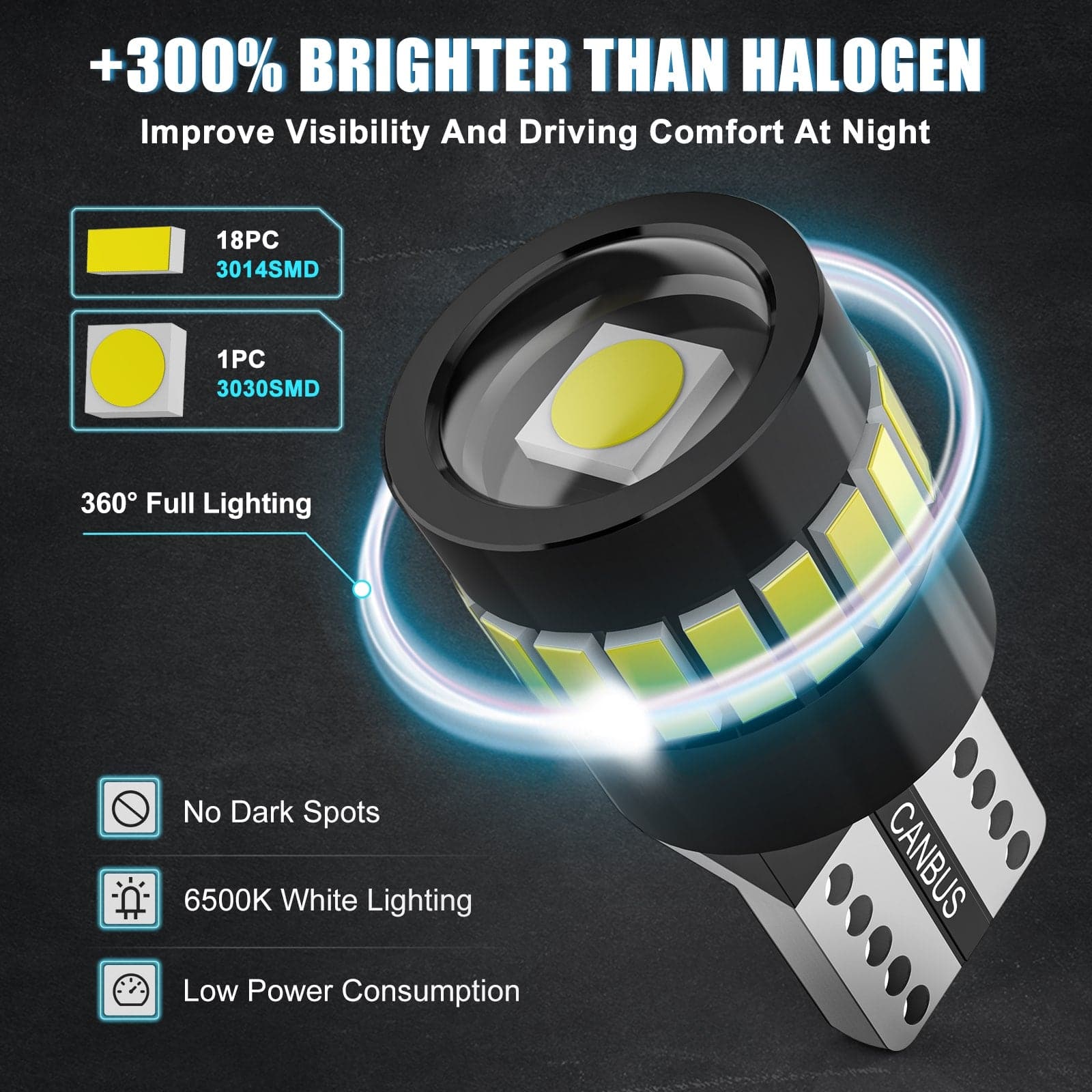When night falls and you click on your car’s headlights, that beam cutting through the darkness isn’t just about visibility—it’s about safety. The debate between LED and HID headlights is more than just a choice between two technologies; it’s about making an informed decision to enhance your night driving experience. Both LED (Light Emitting Diode) and HID (High Intensity Discharge) bulbs have revolutionized automotive lighting with their unique benefits and drawbacks. But which one outshines the other? Let’s dive into a detailed comparison.
High Intensity Discharge (HID)
What Are HID headlight Bulbs?
HID (High Intensity Discharge) headlight bulbs generate illumination without relying on a traditional filament. Instead, these bulbs, often referred to as xenon headlights due to the xenon gas they contain, produce a vibrant, white light through an electrical arc. This characteristic glow is a hallmark of HID technology.
The operation of HID bulbs involves channeling an electric current across a tiny space between two electrodes inside the bulb. This electric arc activates the xenon gas, which then emits a bright and white light. Compared to standard halogen bulbs, HID bulbs are significantly brighter and provide a clearer, whiter light, which is why they are favored by numerous drivers.
HID (High Intensity Discharge) headlights, also known as xenon headlights, have been popular in a variety of vehicle models across several automotive brands. While the adoption of LED technology is increasing, many cars, especially luxury and performance models, have historically been equipped with HID headlights due to their bright and efficient illumination. Here are some examples of car models and brands that have used or continue to use HID headlights:
What cars are designed with HID headlights?
Luxury Brands
- BMW: Many models in the BMW lineup, especially the higher-end series like the 5 Series and 7 Series, have featured HID headlights as standard or optional equipment.
- Mercedes-Benz: Similar to BMW, Mercedes-Benz has equipped many of its models with HID headlights, including the E-Class and S-Class, enhancing their premium feel with superior lighting.
- Lexus: Known for luxury and innovation, Lexus has used HID and later LED headlights across its model range, including the RX and LS models.
Performance Cars
- Audi: Audi has been a pioneer in automotive lighting technology, adopting HIDs early on and integrating them into models like the A4 and A6.
- Porsche: High-performance cars such as the Porsche 911 have utilized HID headlights to offer better visibility at high speeds during night-time driving.
Mainstream Brands
- Ford: The Ford Mustang and certain versions of the Ford Explorer and Fusion have had HID headlights available to enhance visibility and appeal.
- Toyota: Higher trims of models like the Toyota Avalon and Prius have included HID headlights as premium features.
SUVs and Trucks
- Cadillac: Luxury SUVs like the Cadillac Escalade have featured HID headlights to match their upscale and robust aesthetic.
- Acura: SUV models like the Acura MDX have been equipped with HID headlights, offering enhanced visibility in a variety of driving conditions.
It's important to note that as LED technology continues to evolve and decrease in cost, more manufacturers are transitioning to LED solutions due to their efficiency, longevity, and lower power consumption. However, HID headlights remain in use, particularly in models where they are already established as part of the vehicle's design or where consumers continue to appreciate their distinctive, bright light output.
LED (Light Emitting Diode)
What is led headlight?
An LED headlight bulb represents a revolution in automotive lighting, harnessing the power of light-emitting diodes (LEDs) to illuminate the road ahead. Unlike conventional halogen or incandescent bulbs that rely on a heated filament, LED bulbs operate through semiconductors that emit light when an electrical current passes through. This cutting-edge technology offers a plethora of benefits, including enhanced brightness and durability, reduced energy consumption, and a precisely focused beam that enhances visibility while minimizing glare.
What cars needs LED headlight bulbs?
LED headlight bulbs are becoming increasingly popular across various car models and brands due to their numerous advantages over traditional lighting technologies. While not all vehicles necessarily "need" LED headlight bulbs, many drivers opt to upgrade to LEDs for their superior brightness, energy efficiency, and longevity. Here are some scenarios where LED headlight bulbs might be particularly desirable:
Modern Vehicles:
- Newer Models: Many recent car models come equipped with LED headlights as standard or optional features due to their advanced technology and benefits.
- Luxury Cars: High-end vehicles from brands like Audi, BMW, and Mercedes-Benz often include LED headlights to complement their upscale designs and offer superior lighting performance.
- Performance Cars: Sports cars and performance vehicles, such as those from Porsche, often utilize LED headlights to provide enhanced visibility during high-speed driving.
Older Vehicles:
- Halogen Replacement: Owners of older vehicles with halogen headlights may choose to upgrade to LED bulbs for improved brightness and visibility without the hassle of retrofitting HID systems.
- Enhanced Visibility: Drivers in areas with challenging weather conditions or poorly lit roads may opt for LED headlights to enhance their visibility and safety on the road.
- Customization: Car enthusiasts and DIY enthusiasts may install LED headlights as part of a customization project to enhance the appearance and performance of their vehicles.
Specific Applications:
- Off-Road Vehicles: LED headlights are popular among off-road enthusiasts due to their durability and ability to provide bright illumination in rugged terrain and low-visibility conditions.
- Commercial Vehicles: Trucks, vans, and other commercial vehicles may benefit from LED headlights for their long-lasting performance and energy efficiency, reducing maintenance costs and downtime.
While LED headlight bulbs offer numerous advantages, it's essential to ensure compatibility with your vehicle's headlight housing and electrical system before making the switch. Additionally, some jurisdictions may have regulations regarding the use of aftermarket lighting products, so it's essential to verify legality and compliance with local laws before installing LED headlights.
LED vs HID Headlights: Which is Better?
LED advantages over HID headlights
- LED headlights offer several advantages over HID (High Intensity Discharge) headlights, making them a preferred choice for many drivers. Here's why LED headlights shine brighter:
- Extended Lifespan: LED bulbs boast an impressively long lifespan, outlasting HID bulbs by a significant margin. While HID bulbs typically last between 2,000 and 5,000 hours, LED bulbs can endure up to 50,000 hours of use, providing long-term reliability and reduced maintenance costs.
- Enhanced Visibility: LED headlights emit a brighter and more natural light compared to HID bulbs, enhancing visibility and reducing eye strain during nighttime driving. This superior illumination helps drivers discern road hazards more clearly, promoting safer journeys on dimly lit roads.
- Instant On/Off: Unlike HID bulbs that require a warm-up period to reach their full brightness, LED bulbs illuminate instantly upon activation. This immediate illumination ensures better visibility the moment the headlights are switched on, improving safety by minimizing response time in critical situations.
- Simplified Installation: Many LED headlight bulbs are designed with user-friendly plug-and-play solutions, simplifying the installation process for drivers. In contrast, HID lights necessitate the use of a ballast to stabilize the light output, adding complexity and potential complications during installation.
With their longer lifespan, superior visibility, instant illumination, and ease of installation, LED headlights offer a compelling package of benefits that outshine traditional HID headlights, providing drivers with a brighter, safer, and more efficient lighting solution for their vehicles.
Certainly! While LED headlights offer numerous benefits, HID (High Intensity Discharge) headlights also have their strengths. Here's why HID headlights still hold their ground:
- Extended Reach: HID bulbs excel in illuminating objects at a greater distance compared to LED bulbs. This enhanced range provides drivers with better visibility of the road ahead, particularly in environments with long stretches of unlit roads or when driving at high speeds.
- Initial Cost Advantage: For drivers on a budget, HID headlights present a more affordable option compared to LED headlight bulbs, at least initially. While LED bulbs may offer longer-term cost savings due to their extended lifespan and energy efficiency, HID headlights provide a lower upfront investment for those seeking immediate savings.
- Projector Performance: HID headlights often deliver superior beam patterns when used with projector-style headlamp housings. The focused and well-defined beam produced by HID bulbs in projector setups enhances visibility without causing excessive glare. In contrast, LED headlights may struggle to maintain optimal beam patterns in projector housings, potentially resulting in scattered or glare-inducing light output.
Despite the rising popularity of LED headlights, HID bulbs remain a viable choice for drivers who prioritize extended reach, initial cost savings, or require compatibility with projector-style headlamp systems. By understanding the unique advantages of HID technology, drivers can make informed decisions when selecting the most suitable lighting solution for their vehicles.
LED vs HID headlight: Full Comparison
| LED Headlight Bulb | HID Headlight Bulb | |
| Technology | Semiconductor | Xenon Gas |
| Efficiency | High | Lower than LED |
| Glare | Not strong | Strong |
| Lifespan | 30,000 – 50,000 hours | 2,000 – 3,000 hours |
| Cost | More Expensive | Less expensive than LED |
| Color | Mainly in two different colors | Wide range of color options |
| Warm Up Time | No warm up time | Short warm up time |
| Light Distance | Up to 500 meters | Up to 300 meters |
| Fading | No | Yes |
| Replacement | Simple | Average |
| Bulb Size | Small-Medium | Small |
| Housing Compatibility | Best for reflectorCan be used for projector | Best for projectorShouldn’t be used for reflector |
LED vs HID color temperature
LED:
LED headlight bulbs typically emit light within the 6000-6500K range, producing a natural white light that closely resembles daylight. This color temperature enhances visibility by providing a clear and crisp illumination that makes it easier for drivers to distinguish objects on the road. With its resemblance to natural sunlight, LED light contributes to a more comfortable and familiar driving experience, reducing eye strain and improving overall visibility.
HID:
In contrast, HID bulbs offer a broader spectrum of color temperatures, ranging from warm yellows (3000K – 4300K) to cooler whites (5000K – 6000K) and even blues and purples (8000K and above). While HID headlights with higher color temperatures may emit a striking bluish-white or purple hue, they can pose safety risks on the road. Such extreme color temperatures can cause glare and visual discomfort for other drivers, potentially leading to accidents or hazardous driving conditions.
Understanding the implications of color temperature is crucial for selecting the appropriate headlights for your vehicle. While LED headlights provide a natural and clear white light akin to daylight, HID headlights offer a range of color options that may impact visibility and safety, particularly at higher color temperatures. Ultimately, drivers should prioritize safety and compliance with regulations when choosing between LED and HID headlights for their vehicles.
LED vs HID. Efficiency
LED:
Renowned for their exceptional efficiency, LED headlight bulbs outshine HID counterparts with an impressive 80-90% efficiency rating. This means that the majority of the electrical energy consumed by LED headlights is converted into light, minimizing wastage as heat. The most cutting-edge LED headlamps achieve efficiencies of up to 120 lumens per watt (LM/W), illuminating the road with maximum brightness while conserving energy.
HID:
While HID lights boast effectiveness compared to Compact Fluorescent (CFL) and Incandescent lights, they fall short of LED's efficiency standards. HID headlights exhibit a system efficiency of approximately 90 lumens per watt, lagging behind LED technology due to losses incurred in producing light omnidirectionally and redirecting it towards the desired area.
LED vs HID. Upfront Cost
LED:
When it comes to initial investment, LED headlights often come with a higher price tag compared to HID counterparts. The advanced and newer technology behind LED bulbs contributes to their elevated production costs. However, this upfront expense is offset by the longevity of LED headlight bulbs, which can last up to three times longer than HID bulbs. While drivers may pay more initially, they ultimately save money in the long run by avoiding frequent replacements and maintenance costs.
HID:
HID headlight bulbs present a more affordable option in terms of upfront costs compared to LED alternatives. While the initial purchase price is lower, HID headlights may incur higher maintenance expenses over time due to their reliance on sophisticated components. Similar to classic halogen bulbs, HID bulbs may require replacement or servicing if they become damaged or fade out. This additional maintenance can add up over the lifespan of the vehicle, potentially offsetting the initial cost savings of HID headlights.
LED vs HID. Warm Up Time
LED:
LED bulbs shine brightly from the get-go, boasting the advantage of instant illumination without any warm-up time. As soon as they're turned on, LED headlights provide full brightness, ensuring that drivers enjoy optimal visibility without delay. This immediate illumination offers a clear advantage in situations where quick response times are crucial, enhancing safety on the road.
HID:
In contrast, HID bulbs require a patient wait before reaching their full brightness level. Upon activation, HID headlights can take several seconds to heat up the gas inside the bulb and achieve maximum brightness. This warm-up period may result in a brief delay in optimal visibility, potentially impacting driver perception and reaction times, particularly in urgent situations.
LED vs HID. Design
LED:
LED headlight bulbs are characterized by their straightforward yet effective design. Typically composed of an LED chip, heat sink, locking tab, driver, and connectors, LED bulbs offer simplicity and efficiency. However, due to the inclusion of a fan within the heat sink for thermal management, LED bulbs tend to be larger in size compared to HID counterparts. Despite their larger form factor, LED headlights deliver exceptional performance and longevity, making them a popular choice among drivers seeking reliability and efficiency.
HID:
In contrast, HID headlights adopt a design reminiscent of traditional halogen bulbs. At the core of HID technology lies a pressurized tube filled with gas and metal salts, alongside two tungsten electrodes positioned at each end. When activated, an electric arc forms between the electrodes, ionizing the gas and generating intense light output. Despite their conventional appearance, HID headlights offer superior brightness and efficiency compared to halogen bulbs, making them a compelling choice for drivers prioritizing visibility and performance.
Why LED Headlight Bulbs Better Than HID: 3 Main Reasons
1. Energy-efficient: LED bulbs are more energy-efficient than HID bulbs, consuming less power while providing brighter and more focused light.
2. Longer lifespan: LED headlight bulbs typically have a longer lifespan up to 30,000 hours compared to HID bulbs which only last up to 3,000 hours.
3. Brightness: LED headlight bulb produce a brighter, crisper light than HID, making them better for nighttime driving. LED headlights also offer better visibility in inclement weather conditions, such as rain and fog.
How to Choose A High-quality LED headlight bulbs?
FAQ
Q1: HID vs LED bulbs, which is better for projector headlights?
A: HID. HID bulbs tend to produce more light and often shine further down the road through the projector headlight.
Q2: Can I replace my HID bulbs with LED bulbs?
A: It depends on your specific vehicle and headlight assembly. In some cases, it may be possible to replace HID bulbs with LED bulbs using an adapter or conversion kit, but in some car modes, it may need an additional wiring to install.
Q3: Which is more expensive, HID or LED headlight bulbs?
A: LED bulbs are generally more expensive than HID bulbs upfront, but they typically have a longer lifespan, so they may be more cost-effective in the long run.
Q4: HID vs LED headlight bulbs, which is better for night driving?
A: LED headlight bulbs are considered to be brighter than HID headlights in the same lumen rating. As LED headlights are more effective illumination than HID, and able to reach their maximum brightness almost instantly.




